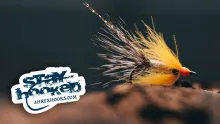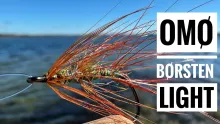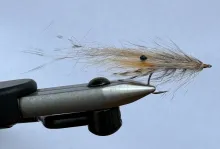"I have severely neglected my day-to-day flybox for more than a year" writes GFF partner Martin Joergensen. Now he sets out to fill a box with hundreds of sea trout flies in preparation for the coming spring. He envisions rows of uniform and neatly arranged flies.
Updated. The flies I fish with on a frequent basis are usually a sad sight. I fish the salt and I'm not good at doing what any saltwater angler should do: rinse everything after a day's fishing.
I don't do that. I have seen my good friend Carsten from Bornholm stick all the flies he has fished during a day into the small sheepskin patch on his jacket and dunking them in a glass of water upon returning home. He then spreads them on a piece of paper tissue and lets them dry before sticking them back in the flybox. I'll bet you he has his flies for years...
I don't
My flies last a few trips. I tend to stick them back in the box while fishing, and not only does that take its toll on the flies that I have fished, but the salt also seems to spread to the flies, which have never seen action!
- Grey Frede
- Red Tag
- Danish Pastry Fly
- Fair Fly
- Small Polar Muddler (or here)
- Omoe Brush
- Moyerfokker
- Epoxy Miracle
- Joergen's Demon
- Bonefish CDC&Elk
- Bloody Butcher
- Klympen
I may add some mullet flies to this batch. Next year I'm going to catch a mullet!
I also tie flies as the need arises. That is usually just a few at a time. Basically what I need for a day of fishing. When I tie more than that it's usually because I experiment. I tie up dozens of strange contraptions, which will never see water because I at waterside regret ever tying them, and just revert to the good old classics.
The net result is a fly box full of rusty, oddball flies that just seem to pile up and never get used. From time to time I then go through the box and remove the worst cases of rusty, fragile hooks, tinted ribbing and collapsed, ugly feathers.
This winter I have set myself a goal, which is forever going to change that - well, maybe not forever, but for a short while at least...
I will produce myself hundreds of neatly tied and uniform flies of my favorite patterns and store them in a special storage flybox, which will never get close to water. I can only take flies out of this box, not put them back in. Not if they have been fished at least.
Two results
One result will be a box full of flies in good condition and an almost-eternal source of new flies that I know I will use in my fishing.
The other result will be this article, which will tell the story, slowly grow and finally be a large epos on filling a Danish coastal flybox.
The first batch
I have already started the project and the last couple of evenings I have produced the first batches of flies. The first pattern I tied was the Grey Frede. I had a really nice bleached and dyed grizzly Chickabou skin that I never really used.
These Frede's changed that.
I have tied about 20 of them and used up my stock of Kamasan B800 size 6's in the process. I will buy some more and tie more Frede's.
Running out of hooks for that pattern, I continued to another: Red Tag. I use this true classic quite a lot, and my box is never without a bunch of them.
I used up my batch of Kamasan B175 hooks size 6 for those and now have a dozen or so. So I need more B175's too. And black tying thread. I ran out of that as well.
But I got started quite well on my fill-the-flybox winter project.
Motivation
Since I have not bought any new hooks yet, I'll take this opportunity to explain to you why I have chosen the particular patterns.
Grey Frede/Magnus
This is Danish coastal classic, which no flybox on a Baltic coast should be without. I am sure this fly would catch bonefish too, and bass, and of course large brown trout.
It is in essence a grey Woolly Bugger with a twist. I tied the first bunch for this project with some slight variations, kind of a hybrid between the Frede and the Magnus, but will later tie some, which are true to the original. Full tying description here.
Red Tag
I like Red Tags. A fishing friend of mine once said: "flies with peacock herl always catch fish", and the combination of herl and red wool is infallible. I often use Red Tags in small sizes when the water is calm or very clear. Full tying description here.
Danish Pastry Fly
Some flies just work, and this is one that works for me. Its history has been told here already. One thing, which remains to be told, is that 74 out of the 120 sea trout I have caught during the last three years have been taken on this pattern. Full tying description here.
Fair Fly
I love large zonkers and this is one of my favorites for sea trout. Sometimes I just want something with some size and volume. This fly does a good job of that. Full tying description here.
Small Polar Muddler
Muddlers are a must in my box, and even though I have been hooked on foam flies for a while, I still adore and prefer muddlers. During the summer I usually spend some nights on the coast, and muddlers are flies of choice for such occasions. Full tying description here.
Omoe Brush
This is my friend Kens pattern, and even though it's been a couple of years since I last had a fish on one, I love the fly and see others have success with it. It is a great generic pattern, which can be taken for a small clam worm as well as a large gammerus. Full tying description here.
Moyerfokker
For those few days with dirty water and lots of waves. This is a noisy fly with a size and an appearance that will make it visible in even the murkiest of waters. Full tying description here.
Epoxy Miracle
I have caught a few fish on Kasper's pattern, but all too few. Considering how many sand eels we see, this has to be able to get even more fish. Full tying description here.
Joergen's Demon
My friend Joergen's variation of the Big Hole Demon has been a permanent part of my boxes over the years. I usually have too few of them. That will be changed this year. This fly has done me particularly well on Bornholm where I intend to spend a spring week again in 2006.
Bonefish CDC&Elk
Paul Slaney's bonefish fly has been my stealth fly of choice for a couple of years. Its soft landing and slow upside-down descent to the bottom makes it a good "sneaky" fly for calm, clear conditions. More here.
Bloody Butcher
I fish this mostly because I just love the pattern: silver, red and black. If the water is clear but turbulent, this is a fly I like to use. Full tying description here.
Klympen
Klympen is a strange construction, but it has its clear advantages, first and foremost its ability to sink fast even in small sizes. I have had good luck on rainbows with this fly. Full tying description here
Next I will bring you detailed photos of all patterns as I start tying them and of course let you see the box fill slowly and give you the patterns.
In the meantime you can read about my flybox as it looked a few years ago. Not much has changed, actually.
One side
A couple of evenings ago I finished one side of the box. Now, this is a large box, which even has a center leaf, so it essentially has three "sides", but still. A quick count told me that I now have about 40 Grey Frede variants, and about 40 Red Tags - half with bead chain eyes and half without. On top of that I have about 20 Jorgen's Demon's in two sizes.
I'm now going on to tie Klympen, a pattern not yet described on this site, but I will probably shoot some step-by-step iamges of the process and make an article while I'm at it. After that it's muddlers. I owe some muddlers for a book on the subject, and I'll tie up a whole bunch and ship the best ones off to the US.
Christmas
It's the 24th of december and after having put the traditional Danish goose and duck (yes, we're having both!) in the oven, I have been tying flies again.
This time I have been finishing the row of Danish Pastry Flies. This has been my most succesful pattern the last couple of years, and is bacause of that a pattern that I will need in large numbers. I will tie at least two rows of this one, summing up to about 40 flies. The fly is quick and easy to tie, and it's a perfect choice for speed tying.
Yesterday I finished a row of another favorite, my friend Henning's Klympen. I will return to this fly and make an article on the pattern, it's history, variations and how to tie it. It is another of our recent patterns, which has shown itself to be very efficient. It's not quite as easy to tie, not least because it requires a layer or two of varnish over the copper wire body before the front part can be finished. I will return to this fly.
Until then: enjoy your Christmas!
New Year
Today is the 31st of December 2005 and tonight we're celebrating New Year. My project has been stading still for a few days now. This has several reasons. I have had a lot of other things to do like celebrating Christmas, redecorating the living rooms, being out in the snow and other stuff. I have also been reading a lot, so expect even more book reviews on the site. And I have been watching a lot of movies on tv. For some reason there seems to be an abundancy of movies on tv during the holiday.
The tv-watching has brought me another disturbing element. I have started constructing a small tying bench, which I can have on my lap so that I can tie flies when I'm watching tv. That project is coming along well, and you can rest assured that it will develop into an article on GFF.
Apart from that I have tied a few more Danish Pastry flies, and soon the boxes' lid and bottom will be filled with about 150 flies altogether. There is a hinged middle part too, and either that or another smilar box is going to contain at least another 150. And I may keep on beyond that. With at least 300 flies in my storage boxes, I will feel ready for the Danish coast when the snow melts and the ice breaks.
More to come...
Ok, I know...
I never got around to update this article with further content. Even though the winter was long and cold and spring never really came, we suddenly had great fishing conditions and started to catch fish.
And who wants to tie flies and write GFF stuff when the fish are jumping?
I will return to the article and the fly tying when I start seeing too many empty slots in the fly box.
- Martin
- Log in to post comments






















Very good article,I
Very good article,I have allway's wondered about people who have time to keep and neat and tidy box of flies who are they trying to impress not me if you've got time to clean and keep your fly box neat and tidy you're not fishing.Also like you I belive in the K.I.S.S.(keep it simple stupid) theory so I only tie patterns that work and keep a box of flies that are just ones that failed who knows maybe the'll work on some body of water you never know well back to tying keep up the goo stories comming and let the fur and feathers fly
David A Swart
davidaswart@GmAIL.COM
Brian,
All these
Brian,
All these flies will do fine any time of year. The difficulty is not finding the flies, but finding the fish!
In general smaller and duller flies are considered better in the autumn, and last year it was flies like Magnus, Honey Shrimp and small crest bug like patterns that worked.
Martin
Are these flies usab
Are these flies usable during ermmm...let's say a GFF summit late september :) ? I can't find so many pages on flies for late summer. Most flies i see are spring and winter types.
Serge,
These flie
Serge,
These flies will catch most fish that swim... at least the ones eating stuff subsurface, which most fish actually do most of the time. I know that it will be hard catching a fish feeding on midges or chironomids on one of these guys, but if your brook trout eat baitfish or shrimps on occasion and can be enticed by a downstream swung fly, these patterns will probably work.
Martin
Hi Martin, superb fl
Hi Martin, superb flies! Do you think I could catch sea brook trouts with these flies in my area : Quebec, Canada (along the Gaspe Peninsula) So far I have not been successful with the flies I am using (brown hackle, Mickey fin, Adams, etc). Thank you for your help.
Dear Martin,
Like
Dear Martin,
Liked your article with all the nice pictures a lot, it gave me some drive and motivation to put out the vise again to fill up some patterns which are low in stock.
Discovered your site first while I was doing some research in regard of a blank for a rod building job. In general I like the globalflyfisher website and pass by at least every one or two months to check what's new.
My personal world of fishing has two hot spots, one is Northern America with a lot of good suppliers and manufacturers of fishing equipment and some good sites in regard of rod building. The other is the Scandinavian area where I prefer to go fishing, also with some good manufacturers of equipment as well. So what makes the difference between your site in regard of the content and other sites is that it is not a pure regional site like some others, on top it represents exactly the areas which are of my personal interest in this regard.
This just as a small feedback from the internet.
RGDS,
Ole
Hamburg/Germany